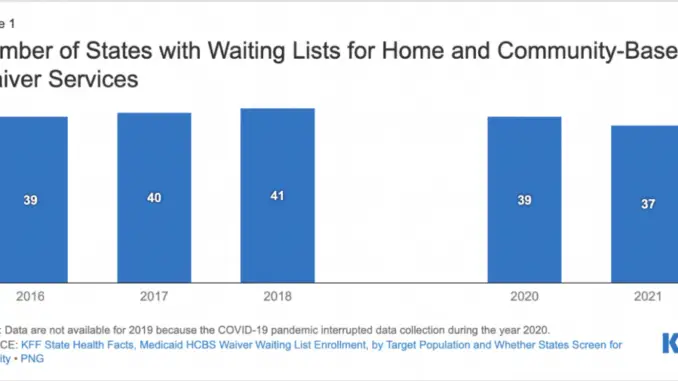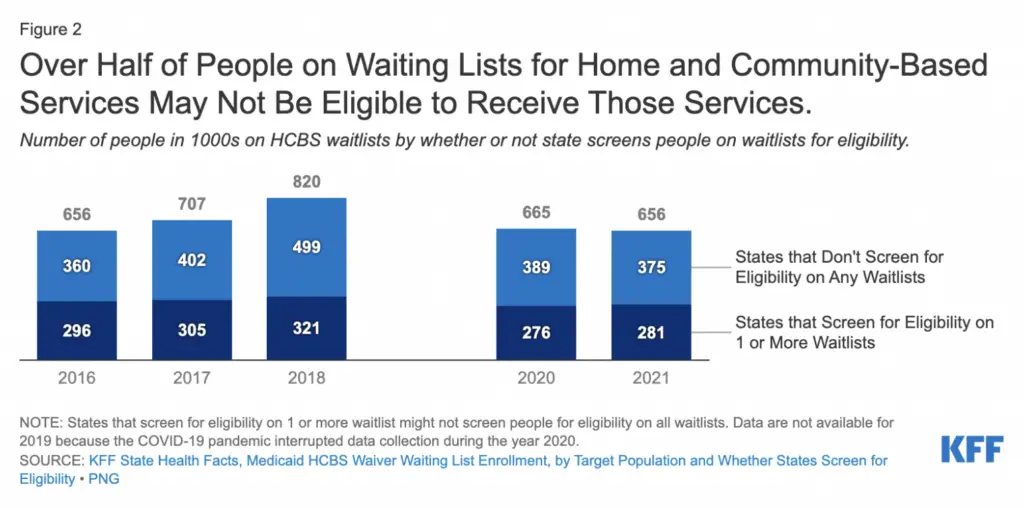
More than half a million people across the U.S. were on state waiting lists for home- and community-based services (HCBS) in 2021.
But the number of states that have a waiting list for people who are in need of HCBS is the lowest it’s been since 2016 at 37.
However, HCBS waiting lists are often incomplete and sometimes inaccurate, making it difficult to quantify the unmet need for the services financed through Medicaid waivers.
In 2021, about 656,000 people were on HCBS waiting lists, according to the Kaiser Family Foundation (KFF). That’s lower than the nearly 820,000 individuals that were on Medicaid waitlists for HCBS in 2018.
Home- and community-based services are a way to fill gaps in care for seniors with complex medical conditions. Medicaid is often the main source of coverage for long-term services and supports (LTSS).
There are well over 2 million individuals receiving HCBS services, but the way waiting lists are calculated can be an unscientific process that can both overstate and understate unmet needs, according to KFF.
For example, not all states screen for Medicaid eligibility before adding people to HCBS waiting lists. That can inflate the number on a waiting list by adding people who may never be eligible for services.
In its most recent analysis, KFF found that over half of people on HCBS waiting lists lived in states that did not screen people on waiting lists for eligibility.
The only HCBS that states are required to cover is home health care, but states can choose to cover personal care and other similar services.
Waiting lists can also understate need. States choose which populations they serve through the Medicaid waiver and what resources they will commit.
People may need services, but if the state doesn’t offer them — or doesn’t offer them to people over 65, for example — those individuals would not appear on a waiting list.
“Even though HCBS waiting lists are an imperfect measure of unmet need, there are no other measures available,” KFF wrote in its summary. “Therefore, waiting lists remain a source of concern to policymakers, and proposals to eliminate them have been put forth by both Republicans and Democrats.”
Takeaways from KFF analysis
Despite the inconsistency between states, KFF reports that the number of people on these waiting lists is trending down.
The number of people on waiting lists has fluctuated. The number was about 656,000 in 2016, rose to about 820,000 in 2018 and is now believed to be about 656,000 again.
But even the individuals who are currently on HCBS waiting lists may not be eligible for those services when their time comes, adding to the murkiness of an imperfect calculation.

A recent study done by the Medicaid and CHIP Payment and Access Commission on HCBS waiting lists found that when waiver services are provided on a first-come, first-served basis, people joined waiting lists in anticipation of future need.
Waiting lists will also fluctuate based on changes made by states and their eligibility requirements.
In 2018, Louisiana had nearly 30,000 people on its waiting lists for intellectual or developmental disabilities (I/DD) services.
That year, the state implemented a new system that was designed to determine if individuals required services soon to avoid institutionalization. Those that met the criterion were provided services. Those that did not were put on a registry and were screened regularly upon request.
By 2020, the waiting list was eliminated, but that doesn’t mean people are not still technically waiting for those services.
In 2021, people on the waiting lists waited an average of 45 months to receive HCBS waiver services, according to KFF. That was up slightly from 44 months in 2020 with 29 of 37 states responding.
People with I/DD waited the longest for services: 67 months on average.
Looking ahead, KFF cited the continued shortages of direct care workers and insufficient state funds as challenges still facing HCBS delivery.
“It remains to be seen how policy changes enacted during the pandemic will affect the provision of HCBS in future years and whether the investments in HCBS through the American Rescue Plan Act will result in capacity increases even after the federal funding ends,” the report read.
The post A Closer Look At The Millions Of People On HCBS Waiting Lists appeared first on Home Health Care News.